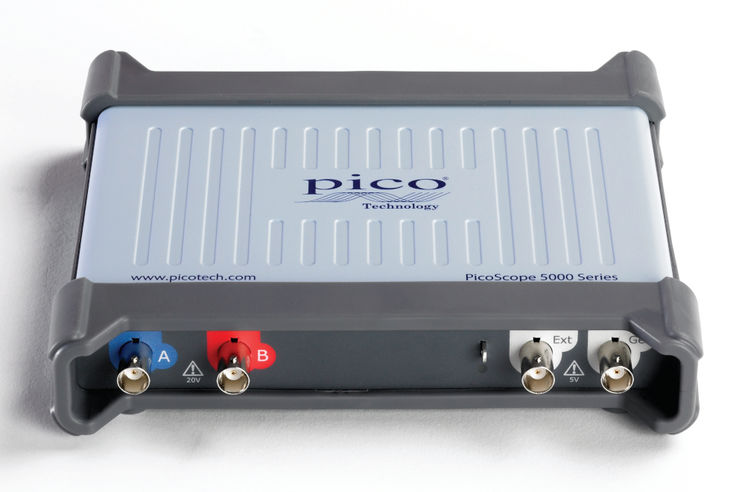Pico Technology 5244D
Oscilloscope USB à résolution flexible - 2 voies, 200MHz, 512Mpts - AWG - Avec ou sans MSO
Version à choisir en option:
- AVEC entrée trigger externe SANS analyse logique (MSO).
- SANS entrée trigger externe AVEC analyse logique (MSO).
------------------------
Oscilloscope USB à résolution flexible.
2 voies.
Bande passante: 200MHz
Mémoire tampon: 512Mpts.
Générateur de fonctions et arbitraire.
Connectique USB 3.0.
Pas d'alimentation externe (Alimenté par le port USB).
Echantillonnage: 1GEch/s (1 voie, 8 bits); 500MEch/s (2 voies, 8 bits).
Résolution: 8, 12, 14, 15, 16 bits.
Déclenchements: Front, fenêtre, largeur d'impulsion, fenêtre de largeur d'impulsion, "perte", fenêtre sur "perte", intervalle, logique.
Décodage: CAN, LIN, I²C, UART/RS-232, SPI, I²S, FlexRay.
Générateur:
1 voie.
Bande passante: DC jusqu'à 20MHz.
Echantillonnage: 200MEch/s (géné arbitraire).
Résolution 14 bits.
Signaux de sortie: Sinus, Carré, Triangle, tension DC, Arbitraire.
Interface PC USB, logiciel PC pour paramétrage et visualisation des courbes.
Dimensions: 190x170x40 mm.
Poids: 500g.
PicoScope® 5000 Series
FlexRes® Oscilloscopes
High speed and high resolution. Breakthrough ADC technology switches from 8 to 16 bits in the same oscilloscope.
Models
| PicoScope® | ||||||||||||
| 5242D | 5242D MSO | 5243D | 5243D MSO | 5244D | 5244D MSO | 5442D | 5442D MSO | 5443D | 5443D MSO | 5444D | 5444D MSO | |
| Channels | 2 | 4 | ||||||||||
| Bandwidth | 60 MHz | 100 MHz | 200 MHz | 60 MHz | 100 MHz | 200 MHz | ||||||
| Buffer (depth) memory | 128 MPts | 256 MPts | 512 MPts | 128 MPts | 256 MPts | 512 MPts | ||||||
| Arbitrary & function generator | 20MHz (FG); 200MHz (AWG) | |||||||||||
| MSO function | Non | Oui | Non | Oui | Non | Oui | Non | Oui | Non | Oui | Non | Oui |
| External trigger input | Oui | Non | Oui | Non | Oui | Non | Oui | Non | Oui | Non | Oui | Non |
Flexible Resolution USB Oscilloscope
- FlexRes 8 to 16-bit hardware resolution
- Up to 200 MHz analog bandwidth
- 1 GS/s sampling at 8-bit resolution
- 62.5 MS/s sampling at 16-bit resolution
- Up to 512 MS capture memory
- 16 digital channels on MSO models
- 130 000 waveforms per second
- Built-in arbitrary waveform generator
- 18 serial decoding protocols as standard
- Up to 200 MHz spectrum analyzer
Today’s electronic designs employ a wide range of signal types: analog, digital, serial (both high- and low-speed), parallel, audio, video, power distribution and so on. All need to be debugged, measured and validated to ensure that the device under test is functioning correctly and within specification.
To handle this variety of signal types, PicoScope 5000D FlexRes hardware employs multiple high-resolution ADCs at the input channels in different time-interleaved and parallel combinations to optimize either the sampling rate to 1 GS/s at 8 bits, the resolution to 16 bits at 62.5 MS/s, or other combinations in between – you select the most appropriate hardware resolution for the requirements of each measurement.
2 and 4 channel models are available, all featuring a SuperSpeed USB 3.0 connection, providing lightning-fast saving of waveforms while retaining compatibility with older USB standards. The PicoSDK® software development kit supports continuous streaming to the host computer at rates up to 125 MS/s. The product is small and light, and operates silently thanks to its low-power fanless design.
Supported by the free-of-charge and regularly updated PicoScope 6 software, the PicoScope 5000D Series offers an ideal, cost-effective package for many applications, including design, research, test, education, service and repair.
What is FlexRes?
Pico FlexRes flexible resolution oscilloscopes allow you to reconfigure the scope hardware to increase either the sampling rate or the resolution. This means you can reconfigure the hardware to be either a fast (1 GS/s) 8-bit oscilloscope for looking at digital signals, or a high-resolution 16-bit oscilloscope for audio work and other analog applications. Whether you’re capturing and decoding fast digital signals or looking for distortion in sensitive analog signals, FlexRes oscilloscopes are the answer.
Deep capture memory
PicoScope 5000D Series oscilloscopes have waveform capture memories ranging from 128 to 512 million samples – many times larger than traditional benchtop scopes. Deep memory enables the capture of long-duration waveforms at maximum sampling speed. In fact, the PicoScope 5000D Series can capture waveforms over 500 ms long with 1 ns resolution. In contrast, the same 500 ms waveform captured by an oscilloscope with a 10 megasample memory would have just 50 ns resolution.
Deep memory can be useful in other ways too: PicoScope lets you divide the capture memory into a number of segments, up to a maximum of 10 000. You can set up a trigger condition to store a separate capture in each segment, with as little as 1 µs dead time between captures. Once you have acquired the data, you can step through the memory one segment at a time until you find the event you are looking for. Powerful tools are included to allow you to manage and examine all of this data. As well as functions such as mask limit testing and color persistence mode, PicoScope 6 software enables you to zoom into your waveform by a factor of several million. The Zoom Overview window allows you to easily control the size and location of the zoom area.
Other tools, such as DeepMeasureTM, serial decoding and hardware acceleration work with the deep memory, making the PicoScope 5000D Series among the most powerful oscilloscopes on the market.
Mixed-signal models
The PicoScope 5000D MSO models add 16 digital channels to the 2 or 4 analog channels, enabling you to accurately time-correlate analog and digital channels. Digital channels may be grouped and displayed as a bus, with each bus value displayed in hex, binary or decimal or as a level (for DAC testing). You can set advanced triggers across both the analog and digital channels. The digital channels can also be used as sources for the serial decoders, giving up to 20 channels of data – for example decoding multiple SPI, I²C, CAN bus, LIN bus and FlexRay signals all at the same time.
Advanced digital triggering
The PicoScope 5000D Series offers an industry-leading set of advanced triggers including pulse width, runt pulse, windowed and dropout.
The digital trigger available on MSO models allows you to trigger the scope when any or all of the 16 digital inputs match a user-defined pattern. You can specify a condition for each channel individually, or set up a pattern for all channels at once using a hexadecimal or binary value. You can also use the logic trigger to combine the digital trigger with an edge or window trigger on any of the analog inputs, for example to trigger on data values in a clocked parallel bus.
Arbitrary waveform and function generator
All PicoScope 5000D units have a built in 14-bit 200 MS/s arbitrary waveform generator (AWG). You can create and adapt arbitrary waveforms using the built-in editor, import them from existing oscilloscope traces, or load a waveform from a spreadsheet.
The AWG can also act as a function generator with a range of standard output signals, including sine, square, triangle, DC level, white noise and PRBS. As well as the basic controls to set level, offset and frequency, more advanced controls allow you to sweep over a range of frequencies.
Combined with the spectrum peak hold option, this makes a powerful tool for testing amplifier and filter responses. Trigger tools allow you to output one or more cycles of a waveform when various conditions are met, such as the scope triggering or a mask limit test failing.
Software Development Kit - write your own apps
The software development kit (SDK) allows you to write your own software and includes drivers for Microsoft Windows, Apple Mac (macOS) and Linux (including Raspberry Pi and BeagleBone).
Example code shows how to interface to third-party software packages such as Microsoft Excel, National Instruments LabVIEW and MathWorks MATLAB.
There is also an active community of PicoScope users who share code and applications on the Pico forum and PicoApps section of the picotech.com web site. The Frequency Response Analyzer shown opposite is one of the most popular third-party applications.
High-end features as standard
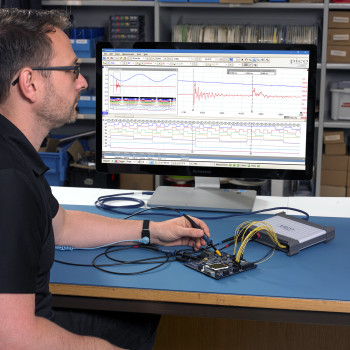
High bandwidth, high sampling rate
Despite the compact size and low cost, there is no compromise on performance, with bandwidths up to 200 MHz. This bandwidth is matched by a real-time sampling rate of 1 GS/s, allowing detailed display of high frequencies. With a real-time sampling rate of five times the input bandwidth, PicoScope 5000 Series oscilloscopes are well equipped to capture high-frequency signal detail. For repetitive signals, the maximum effective sampling rate can be boosted to 10 GS/s by using Equivalent Time Sampling (ETS) mode.

Serial bus decoding and analysis
With its deep memory, the PicoScope 5000D Series can decode 1-Wire, ARINC 429, CAN and CAN-FD, DCC, DMX512, Ethernet 10Base-T and 100Base-TX, FlexRay, I²C, I²S, LIN, PS/2, MODBUS, SENT, SPI, UART (RS-232 / RS-422 / RS-485) and USB 1.1 protocol data as standard.
Decoding helps you see what is happening in your design to identify programming and timing errors and check for other signal integrity issues.
Timing analysis tools help to show the performance of each design element, identifying parts of the design that need to be improved to optimize overall system performance.

Graph format shows the decoded data (in hex, binary, decimal or ASCII) in a timing diagram format, beneath the waveform on a common time axis, with error frames marked in red. You can zoom in on these frames to investigate noise or distortion, and each packet field is assigned a different color, so the data is easy to read.

Table format shows a list of the decoded frames, including the data and all flags and identifiers. You can set up filtering conditions to display only the frames you are interested in or search for frames with specified properties. The statistics option reveals more detail about the physical layer such as frame times and voltage levels. PicoScope can also import a spreadsheet to decode the data into user-defined text strings.
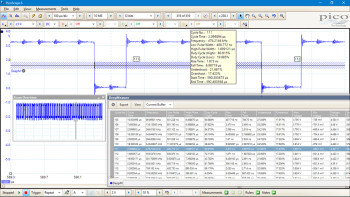
DeepMeasure
One waveform, millions of measurements
Measurement of waveform pulses and cycles is key to verification of the performance of electrical and electronic devices.
DeepMeasure delivers automatic measurements of important waveform parameters on up to a million waveform cycles with each triggered acquisition. Results can be easily sorted, analyzed and correlated with the waveform display.

Waveform buffer and navigator
Ever spotted a glitch on a waveform, but by the time you’ve stopped the scope it has gone? With PicoScope you no longer need to worry about missing glitches or other transient events. PicoScope can store the last ten thousand oscilloscope waveforms or spectrum plots in its circular waveform buffer.
The buffer navigator provides an efficient way of navigating and searching through captured waveforms, effectively letting you turn back time.
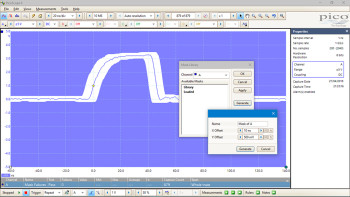
Mask limit testing
Mask limit testing allows you to compare live signals against known good signals, and is designed for production and debugging environments.
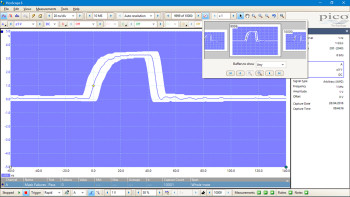
Simply capture a known good signal, draw a mask around it, and then attach the system under test. PicoScope will check for mask violations and perform pass/fail testing, capture intermittent glitches, and can show a failure count and other statistics in the Measurements window.
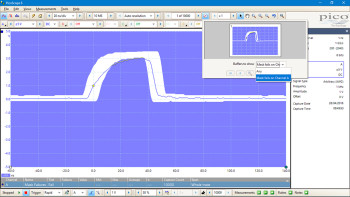
Use the Buffer navigator to find waveforms that violate the mask.
In this case 10 000 waveforms have been captured in the buffer. Just one of those waveforms, which violated the mask, is easily found by selecting "Mask fails on Channel A" in the navigator.

Advanced digital triggering
The majority of digital oscilloscopes still use an analog trigger architecture based on comparators. This causes time and amplitude errors that cannot always be calibrated out and often limits the trigger sensitivity at high bandwidths.
In 1991 Pico pioneered the use of fully digital triggering using the actual digitized data. This technique reduces trigger errors and allows our oscilloscopes to trigger on the smallest signals, even at the full bandwidth. Trigger levels and hysteresis can be set with high precision and resolution.
The sub-1 µs rearm delay provided by digital triggering, together with segmented memory, allows up to 10 000 waveforms to be captured in a 10 ms burst.
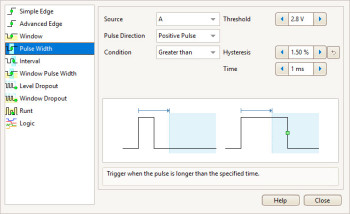
The PicoScope 5000 Series offers an industry-leading set of advanced triggers including pulse width, runt pulse, windowed, logic and dropout.

On PicoScope 5000D MSO models the digital channels can be used to form a logic trigger with Boolean operators.

FFT spectrum analyzer
The spectrum view plots amplitude against frequency and is ideal for finding noise, crosstalk or distortion in signals. The spectrum analyzer in PicoScope is of the Fast Fourier Transform (FFT) type which, unlike a traditional swept spectrum analyzer, can display the spectrum of a single, non-repeating waveform.
A full range of settings gives you control over the number of spectrum bands (FFT bins), window types, scaling (including log/log) and display modes (instantaneous, average, or peak-hold).

You can display multiple spectrum views alongside oscilloscope views of the same data. A comprehensive set of automatic frequency-domain measurements can be added to the display, including THD, THD+N, SNR, SINAD and IMD. A mask limit test can be applied to a spectrum and you can even use the AWG and spectrum mode together to perform swept scalar network analysis.
| 41-Standard Manufacturer Warranty | 5 YEARS |
| 3-Number of analog channels | 2 Channels |
| 694-USB format | USB 3.0 |
| 45-PC interface | USB |
| 4-Bandwidth (Hz) | 200 MHz (oscilloscope); 20 et 200MHz (FG et AWG) |
| 10-Min. Vertical Sensitivity (mV/div) | 2 mV |
| 98-Trigger (Type) | Edge | Logic/Pattern | Runt | Pulse width | Interval | DropOut |
| 5-Sampling rate (S/s) | 1GEch/s (1 voie, 8 bits); 500MEch/s (2 voies, 8 bits) |
| 7-Vertical Resolution (Bits) | 8 Bits | 12 Bits | 14 Bits | 16 Bits |
| 338-MSO/logic analysis (Y/N) | No |
| 6-Record Length (pts) | 512 MPts |
| 674-Built-in generator | Function or waveform | Arbitrary waveform |
| En Stock | No |
| 36-Additional Characteristics |
|
| 132-Package includes | Sondes passives 200MHz (1 par voie), cordon USB double, guide de démarrage rapide, logiciel sur CD |
| 35-Dimension (HxWxD) (mm) | 190x170x40 mm |
| 13-Net Weight | 500 g |
